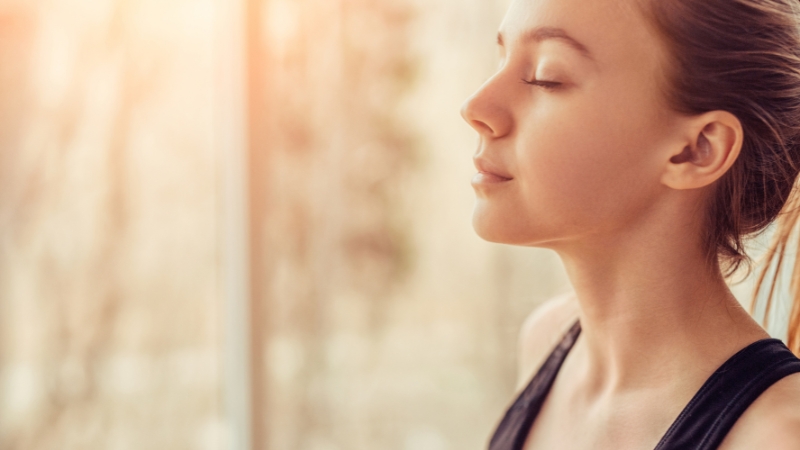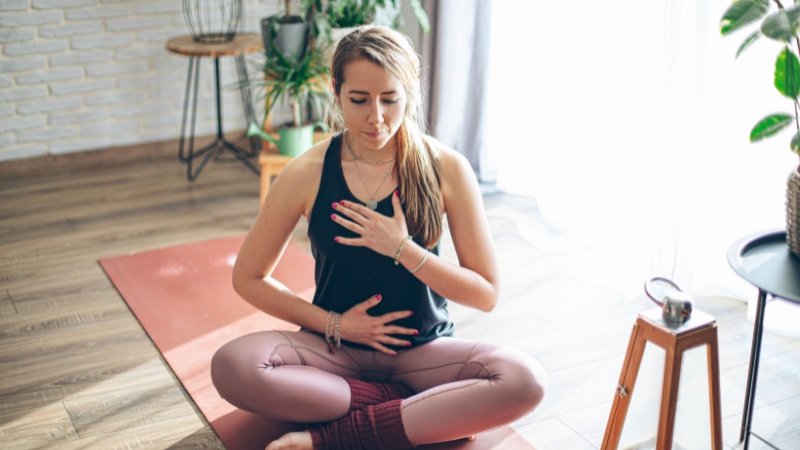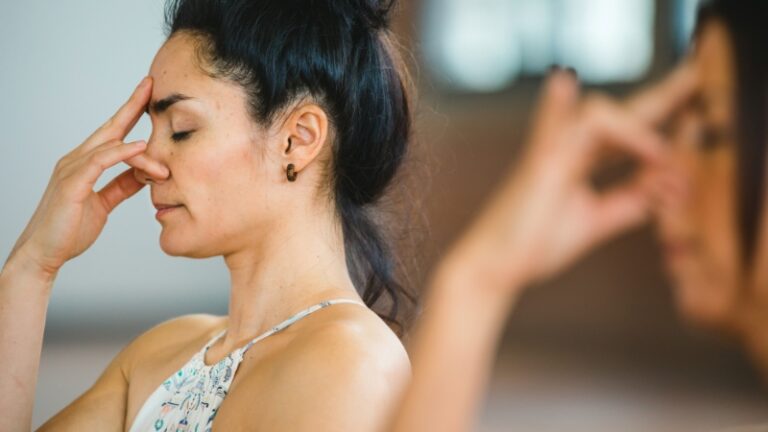Yes, controlled breathing through pranayama is one of the few evidence-based practices that shows immediate effects on anxiety. Unlike meditation or lifestyle changes that require weeks to months for noticeable improvement, breathwork can calm your nervous system in a matter of minutes.
Clinical studies confirm that pranayama reduces cortisol (the stress hormone), slows heart rate, and improves heart rate variability – all markers of lower anxiety. People with generalized anxiety disorder, panic symptoms, or even daily stress often report fewer episodes of racing thoughts and tension after adopting simple breathing exercises.
Anxiety activates the sympathetic nervous system (the fight-or-flight response). Pranayama works by engaging the parasympathetic nervous system, which signals safety, rest, and recovery. In plain terms: you breathe in a way that tells your body “I’m safe,” and your mind follows.
Why Breath Matters So Much in Anxiety

Anxiety isn’t “all in your head.” It’s a full-body experience triggered by the sympathetic nervous system, the fight-or-flight response. Your brain perceives danger, whether real or imagined, and your body reacts with adrenaline, cortisol, rapid heartbeat, and fast, shallow breathing.
Here’s where pranayama makes a difference: when you consciously slow your breath, you activate the parasympathetic nervous system, the part of the body responsible for rest, digestion, and recovery. This is called the vagal brake, and it’s the body’s natural switch for calming down.
Think of it like this: every inhale is a slight accelerator pedal, activating energy, while every exhale is a brake pedal, activating calm. Pranayama teaches you how to lengthen the exhale, restore balance, and remind your body that you’re safe.
The Science Behind It
- Heart rate variability (HRV): Breathwork increases HRV, a marker of resilience to stress.
- Cortisol: Studies show that daily pranayama lowers cortisol, the stress hormone.
- Brain activity: fMRI scans reveal that slow breathing enhances activity in the prefrontal cortex, the brain region tied to rational thought and decision-making, while calming overactive fear circuits in the amygdala.
- Oxygen balance: Controlled breathing improves oxygen-carbon dioxide levels, preventing hyperventilation, which often worsens panic.
Core Pranayama Techniques for Anxiety
1. Nadi Shodhana (Alternate Nostril Breathing)
This technique is excellent for situations where anxiety comes from overthinking or mental overload. It balances the left and right hemispheres of the brain.
How to do it:
- Sit with your spine tall.
- Use your right thumb to close the right nostril. Inhale slowly through the left.
- Close the left with your ring finger, release the right, and exhale.
- Inhale through the right, close it, then exhale left.
- That’s one round. Continue 8–10 rounds.
2. Bhramari (Bee Breath)
View this post on Instagram
When your anxiety feels restless and noisy, Bhramari is a direct antidote. The humming vibration works almost like a sound bath from within your own body.
How to do it:
- Take a full breath in.
- Plug your ears with your fingers.
- Exhale slowly while making a humming “mmm” sound.
- Focus on the vibration in your head and chest.
- Repeat 7–10 rounds.
3. Ujjayi (Ocean Breath)
Known as “the victorious breath,” Ujjayi is often used in yoga. It creates a soothing wave-like sound that keeps your attention on the breath.
How to do it:
- Inhale through the nose with a slight constriction at the throat.
- Exhale the same way, producing a soft ocean-like sound.
- Continue for 5–10 minutes.
4. Sama Vritti (Box Breathing)
@nikyyoga Sama Vritti Pranayama, also known as “equal breathing” is a deeply grounding breath control practice with powerful benefits for anxiety. It’s simple, yet incredibly effective. #authenticyoga #yogaforbeginners #indianyogateacher #breathwork #breathworkhealing #fyp ♬ snowfall – Øneheart & reidenshi
This is the most beginner-friendly technique, also used by Navy SEALs and athletes to manage high-stress moments.
How to do it:
- Inhale for 4 counts.
- Hold for 4 counts.
- Exhale for 4 counts.
- Hold again for 4 counts.
- Repeat for 5–10 minutes.
Which Technique Should You Use?
Situation
Best Technique
Why
Sudden panic, racing thoughts
Box Breathing
Quick reset of breath rhythm
Before an exam, meeting, or social event
Nadi Shodhana
Improves clarity and focus
Restless evenings, trouble sleeping
Ujjayi
Calms body, preps for rest
Irritability, agitation, high stress
Bhramari
Vibrations reduce overactivity
What the Research Shows
Study
Participants
Technique
Outcome
Sharma et al., 2020 (Journal of Clinical Psychology)
72 patients with generalized anxiety
Nadi Shodhana + Bhramari
57% reduction in anxiety scores after 12 weeks
Brown & Gerbarg, 2012 (Harvard Review of Psychiatry)
Adults under chronic stress
Slow breathing protocols
Reduced cortisol, improved mood, better sleep
National Center for Complementary & Integrative Health (NCCIH)
General population
Various
Recognizes slow breathing as effective in reducing stress and anxiety
A Practical 4-Week Routine
Week
Morning
Midday
Evening
1
5 min Box Breathing
—
5 min Ujjayi
2
7 min Nadi Shodhana
3 min Box Breathing before stressful tasks
7 min Ujjayi
3
10 min Nadi Shodhana
5 min Bhramari if agitation rises
10 min Ujjayi
4
Mix 15 min (Nadi + Ujjayi)
Short Box Breathing as needed
Bhramari before bed
By the end of four weeks, most people notice both immediate relief during stress and an overall calmer baseline throughout the day.
Safety Tips
Final Thoughts

Pranayama is powerful because it’s portable. You don’t need a yoga mat, a quiet room, or any equipment. You can practice in your car before a meeting, at your desk during a stressful email, or in bed when your mind won’t stop racing.
The most important part is consistency. Even five minutes a day reshapes how your body responds to stress.
For sudden anxiety spikes, Box Breathing or Bhramari are like emergency brakes. For long-term stability, Nadi Shodhana and Ujjayi train your system to stay calm by default.

